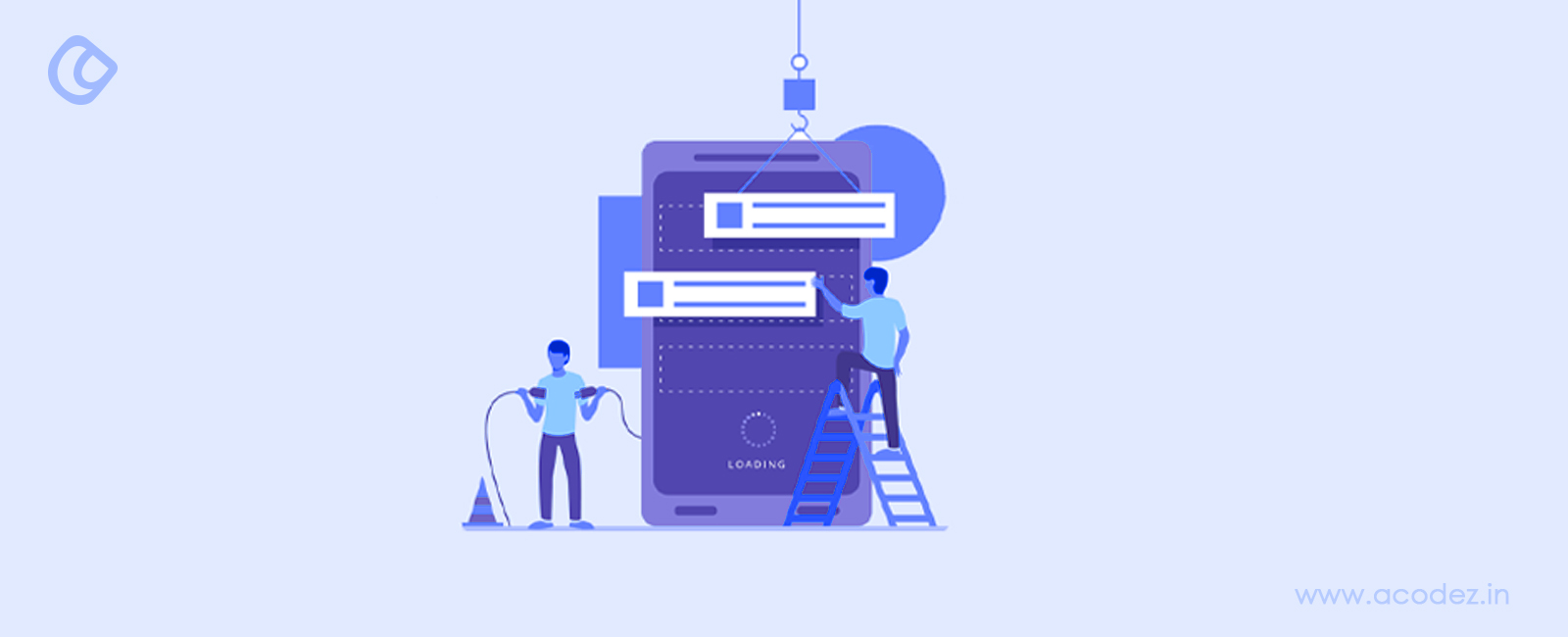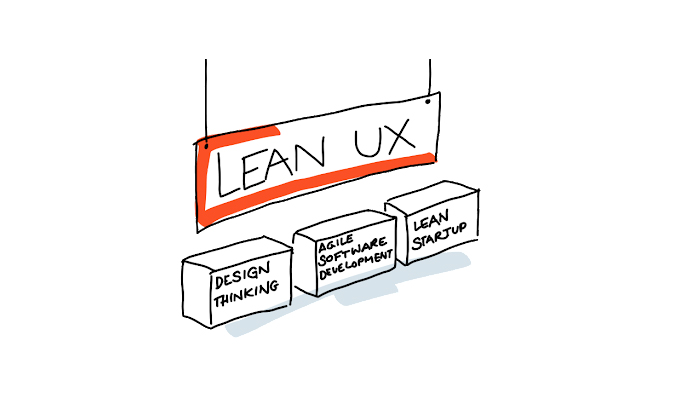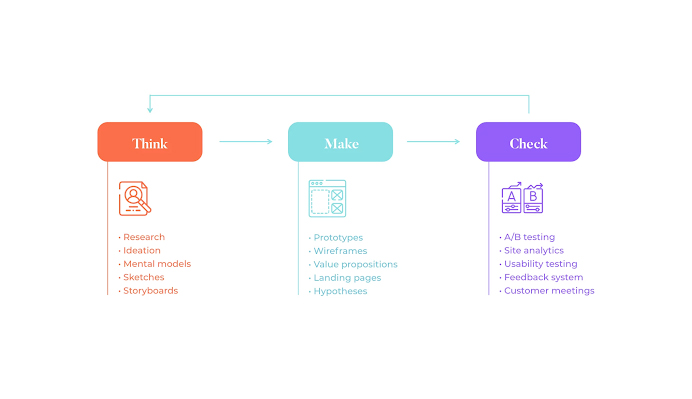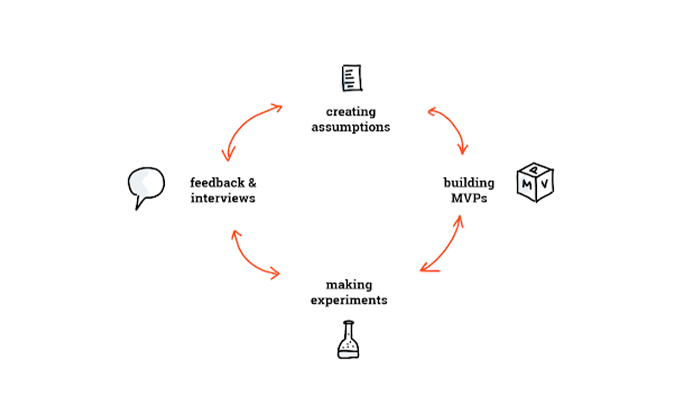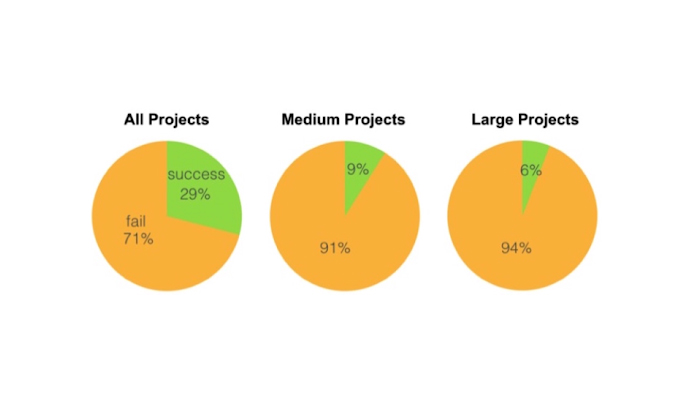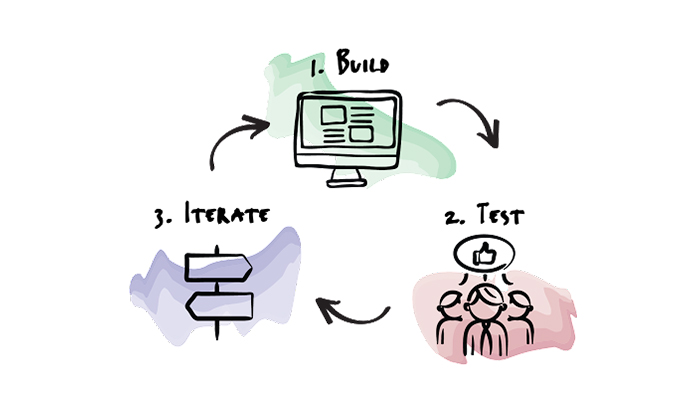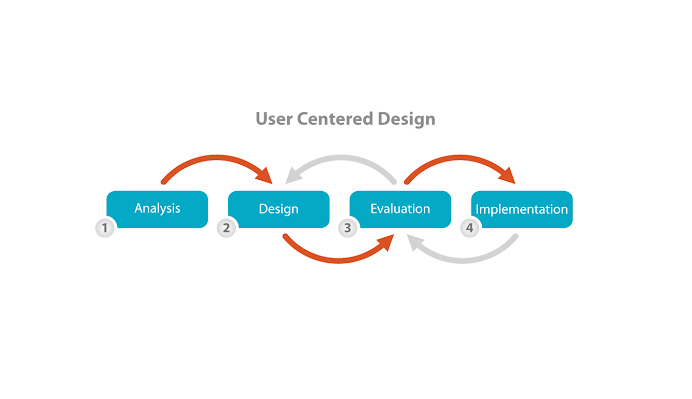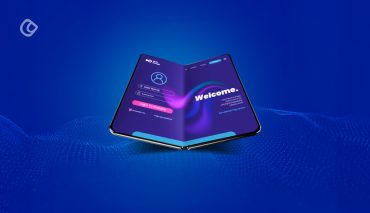An effective management system is essential when it comes to designing experiences that will leave your users speechless.
It is not simple to create a product and trust your customers like it. You must have a procedure in place that makes it possible to develop the product and afterward make modifications as needed.
This necessitates cross-team and cross-departmental collaboration and also frequent engagement with your users.
It also means that designers are under more pressure than it has ever been, not only to offer valuable or better products than anybody else but also to deliver them faster. This pressure has opened a new era of agile working, allowing design teams to collect customer feedback earlier than usual and iterate swiftly.
However, that may appear to be a lot to manage. And besides, how can one keep up with the ever-changing demands and expectations of their consumers while incorporating different teams and interested parties?
That’s why there’s Lean UX.
Lean UX Concept – Image Source: UID
A design management system designed to aid in the creation of well-designed products via regular team discussion, continuous iteration, and regular interaction with your customers.
It is an extremely valuable tool while working on projects that employ the Agile development approach. Traditional UX strategies frequently fail when development occurs in short bursts As there isn’t adequate time to deliver UX in the same manner.
Lean UX, like most design processes, is complicated with a lot of variables or components. However, once your team gets started, you’ll discover that it’s a simple and effective way to gain quick insights.
This is why in this article, we’ll take a deeper look at what is Lean UX and the benefits of Lean UX for designers so that you can begin implementing the approach in your own organization.
What Is Lean UX?
Lean UX design is an outcomes-based UI/UX process that emphasizes collaborations and extensive testing and experimentation on minimum viable products (MVP).
Jeff Gothelf, an organizational designer, introduced Lean UX in 2013 with the publication of Lean UX: Designing Great Products with Agile Teams.
He assisted in the development of the system after experiencing issues with his colleagues at TheLadders. They even drew a diagram outlining the specific issues they were facing with their management system.
The book set the framework for several approaches that businesses might take to their UX process, and it introduced a system that stresses the following:
- Remove waste and time-consuming activities such as regular documentation and instead focus on developing MVPs that promote rapid learning.
- Create a culture of ongoing collaboration by connecting developers and designers together, as well as product managers, quality assurance, advertising, and other partners.
- Encourage constant experimentation in order to gain new insights and learnings about their goods.
In 2021, Jeff Gothelf and Josh Seiden revised the book, focusing on the ideas, methods, and methodologies, as well as lessons on how development teams can combine design, iteration, experimentation, and lifelong learning from actual customers into their Agile process.
In Lean UX. outcomes are prioritized over deliverables.
Instead of developing anything because an individual says or thinks that’s a good idea, design teams must first identify reasons and supporting evidence to accomplish design by replacing what with why (“Why are we designing” instead of “what are we designing”).
Lean UX design is thus more of a cognitive process than a workflow paradigm.
Before committing to producing something, designers must first formulate and test a hypothesis. This is why testing and experimenting with MVP ideas is such an important element of a Lean UX workflow.
The Lean UX Process
Lean UX is all about gathering consumer insights as early as possible in the workflow and using that to create product revisions.
The ultimate goal is for your organization to be able to deploy a final product or project that adds value and provides an effective UX.
After all, a strong emphasis on the end-user experiences is what distinguishes Lean UX from some of the other systems. It’s less about delivering standard UX outputs and more about collaborating on a user-driven approach.
To ensure this approach is implemented, a Lean UX designer always begins with a problem, then innovative and creative solutions and rigorously tests, as seen below.
Lean UX Main Concepts – Image Source: Justinmind
The three main concepts that drive Lean UX are as follows:
- Think: Assumptions, user research, ideation, mental models, sketches, and storyboards.
- Make: Wireframes, prototypes (MVPs), value propositions, landing pages, and hypotheses.
- Check: Analyze data & analytics, usability testing, customer meetings, and user feedback.
Although it may be easy to think of these as three processes that happen in a linear fashion, this is far from the case.
The Lean UX process is a never-ending cycle in which the product improves and advances, with each cycle ending and restarting.
Lean UX Process Concept – Image Source: UID
What Are the Benefits of Lean UX?
Traditional UX design methods include time-consuming stumbling blocks such as monitoring sessions or meetings, needless documentation, team silos, and poor interaction within the departments.
Lean UX improves the UX processes by fostering cross-departmental cooperation and eliminating standards that bring no financial returns or value to the organization.
Lean UX helps teams complete design phases much more quickly and, most crucial, work smarter. Time-saving is also a big element here, which implies there is less waste of resources.
Early feedback from client research and testing results in an improved design. This method prioritizes constant experimentation and raw data above large paper deliverables.
Creating cross-functional teams with members from other departments allows design teams to draw on a wide range of ideas, insights, and views. With this amount of data at their disposal, teams can create better minimum viable products and test more concepts more swiftly.
Now that you realize the difference between traditional UX and Lean UX let’s dig deeper into the benefits of Lean UX. Why do design teams repeatedly select Lean?
- Lean UX Is Cost-Effective
Project management is not inexpensive; it can account for up to 20% of the total project expenditure. Starting a project without sound management or with poor project management will, on the other hand, cause more harm than good.
Adopting Lean management allows you to save money, eliminating any financial harm or risks to your project. So rather than wasting valuable time on a project that will never be completed, the Lean approach ensures teams stay focused on what is important for the organization.
All decisions are validated repeatedly, forming a stable foundation upon which a project can be created. Indeed, this has substantial advantages within itself, and it also generates a financially solid project.
Numerous projects have failed due to major alterations required at the last minute, putting a significant burden on the product’s finances.
Project Failure Rate – Image Source: Medium
In fact, according to a Gartner survey, the failure rate of large projects with costs surpassing $1 million was discovered to be nearly 50% greater than that of programs with budgets less than $350,000.
Among the most commonly reported causes of this failure are high-cost variance and termination.
Everyone in the UX industry understands how late adjustments may derail a UX design project. It’s all about expending funds on verified judgments so that innovation comes swiftly and early when it’s still affordable.
- Increased Collaboration
Lean UX teams are generally cross-functional, and as a result, Lean ideally fosters collaboration and cross-functionality.
This implies that when developing a system, Lean brings together individuals from a number of diverse disciplines, and developers no longer have the freedom to work alone.
In fact, according to Jeff Gothelf, diverse teams develop better solutions since each challenge is seen from several different perspectives. The formation of heterogeneous teams reduces the requirement for gated, handoff-based processes.
Rather, teams can communicate information informally, fostering collaboration sooner in the process and increasing group cohesiveness.
The process, however, necessitates flawless communication and coordination across the whole development team. On a daily routine, regular team engagement is necessary.
Thus, if you are among those committed design professionals, Lean UX will not allow you to keep your entire team having to wait for your help every time anything needs to be figured out.
Furthermore, collaborations in Lean UX are not limited to professionals. Communication and collaboration with clients are also prioritized in practice, letting you share a common insight into the challenges and remedies with consumers.
- Saves Time
The Lean UX system eliminates the waste that most design processes have by reducing parts that do not significantly contribute to the creation of a service or product for consumers. Its methodology is collaborative in nature and does not place a priority on comprehensive documentation.
In fact, according to the Journal of Software Engineering Research and Development (JSERD), “Agile software development (ASD) promotes working software over comprehensive documentation.”
Anything that does not add to the project’s objectives is considered waste and is eliminated swiftly. This approach implies no more extensive paperwork or back-and-forth with designers. Even if the Lean approach isn’t quite linear, it prevents the designers from wasting so much time.
Lean UX focuses on quick and swift solutions with its process framework (think, make, check) rather than longer and longer periods of designing a fully planned product.
Therefore, no point in devoting a significant amount of time to a large project and then testing it once it’s completed.
Lean Cycles – Image Source: Mudbath
Lean UX is also an iterative process.
Analysis and development proceed swiftly and do not take months to complete before being handed to engineers.
The Lean UX process involves both designers and developers. And because everyone owns what they create, everything moves considerably faster than in a typical/traditional design and development process.
- Streamlined Feedback Process
Lean UX is based on the idea that acting rather than just talking about the action or the doing is more useful for design teams.
“There is more value in creating the first version of an idea than spending half a day debating its merits in a conference room,” says Jeff Gothelf.
The most valuable feedback you may receive while creating a product isn’t from a project team member. Your clients (who will use the product/service) provide the most important thoughts and comments.
Client feedback is useful in assisting designers in rethinking current design ideas. Furthermore, they can execute this reframe in accordance with business objectives.
Lean UX offers a fantastic method of thinking about deploying applications. It is also simple for designers to grasp, which is a huge advantage for companies.
However, if you squander time debating and slipping into the feared analysis paralysis, you will produce waste, and that’s not what Lean UX is all about.
- It’s User-Centered
There is a significant connection between User-Centered Design (UCD) and Lean UX.
UCD is an iterative development process in which the design team focuses on clients and their demands throughout the design phases.
User-Centered Design – Image Source: Medium
Its designers employ a combination of research and design methodologies to engage clients all through the design phases in order to develop highly useful and transparent products for them.
UCD and Lean UX place a high value on having validation take the reins. Both methods encourage design teams to step back from the project, with testing serving as a guidepost.
UCD initiatives are built on a clear knowledge of the clients, tasks, and settings. The process’s goal is to record and address the entire UX.
The Lean way, like UCD, is all about building something that certainly fits consumers. This is not just about completing a solid financial project; it’s also about producing a project that fits into the existence of your everyday users.
Through validating all your projects with clients, Lean designers may see their ideas in action, reducing the likelihood of poor project designs in the final phases.
- Improved Product’s Outcome
The outcomes are the aims designers are attempting to achieve.
In Lean UX, design teams strive to achieve a significant and quantifiable change in client interactions and behaviors, which is an outcome. Lean UX progress is measured in terms of clearly defined outcomes.
Whenever design teams try to forecast which elements/features will accomplish specified results, they are generally speculating.
Even though it is easier to oversee the introduction of certain feature sets, designers frequently do not know if a feature will be beneficial unless it is in the hands of the consumer.
According to Jeff Gothelf, “By managing outcomes (and the progress made toward them), we gain insight into the efficacy of the features we are building. If a feature is not performing well, we can make an objective decision as to whether it should be kept, changed, or replaced.”.
This approach allows designers to effectively develop MVPs depending on their assumptions and assess how they function.
And as Jeff Gothelf points out, if the products don’t work effectively, design teams can reach a conclusion about the features (if they will be retained, updated, or removed).
- Eliminates Heavy Deliverables
Another key advantage of Lean UX is that it enables the elimination of time-consuming deliverables.
Project Deliverables – Image Source: TacticalProjectManager
Enhanced methodologies are used, allowing designers to achieve common knowledge with collaborators. Aside from that, lean UX totally changes designers’ viewpoint.
Lean UX changes the design process’s attention away from the documents that the design team is developing. Rather, it concentrates on the design team’s accomplishments.
Client conversations decline dramatically about what product is being developed and much more about which result is being reached as cross-functional collaboration increases.
Traditionally, it was solely about the design elements and the documents. However, since the advent of Lean UX, designer teams have begun to consider the usability and functionality of those elements.
In fact, Jeff Gothelf says that “Documents don’t solve customer problems – good products do”.
The design team’s priority should strive to discover which features or innovations have the most influence on its clients.
The materials used by the design team to acquire and share that insight are meaningless. All that is important is the product’s quality, as evaluated by the client’s responsiveness.
Conclusion
If you value your projects and realize that some features need to be changed, take charge of making the required modifications and ensuring that the adjustments become entrenched in the business world.
Incorporating Lean UX concepts into your innovation activities can increase the efficiency of your design team and improve the quality of your products. Tailor or customize the framework to meet the demands and needs of your design team.
Furthermore, as we’ve discussed throughout this piece, Lean UX produces better results and allows your team to collaborate and achieve design objectives in a significantly short period of time and at a lower cost, unlocking enormous value for your clients.
To sum up, increasingly, design teams are recognizing Lean UX as the design strategy of the long term. We hope these benefits of Lean UX are compelling enough to drive you to keep things agile in your chosen design methods.
Acodez is a leading web design company in India offering all kinds of web design and development solutions at affordable prices. We are also an SEO and digital marketing agency offering inbound marketing solutions to take your business to the next level. For further information, please contact us today.
Looking for a good team
for your next project?
Contact us and we'll give you a preliminary free consultation
on the web & mobile strategy that'd suit your needs best.


